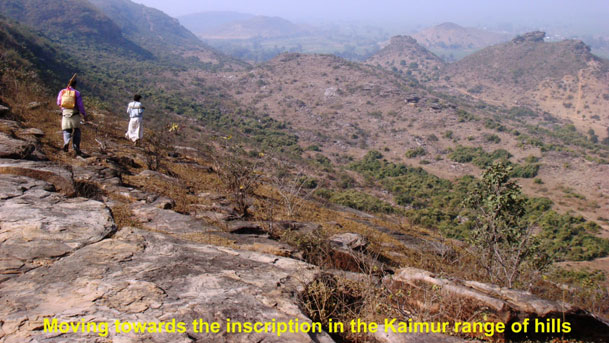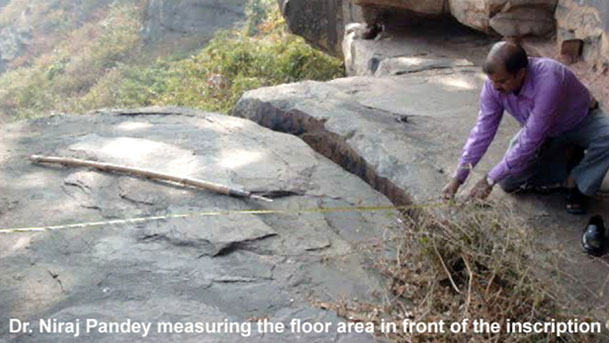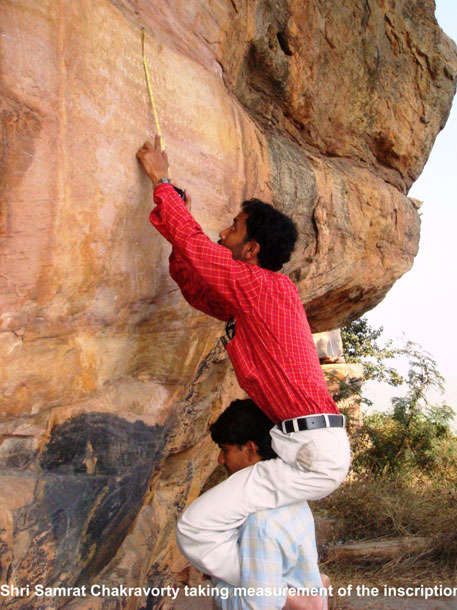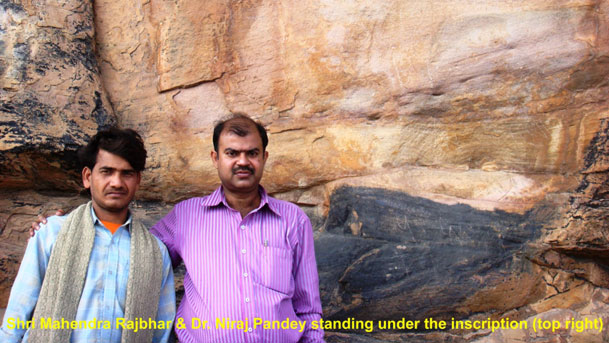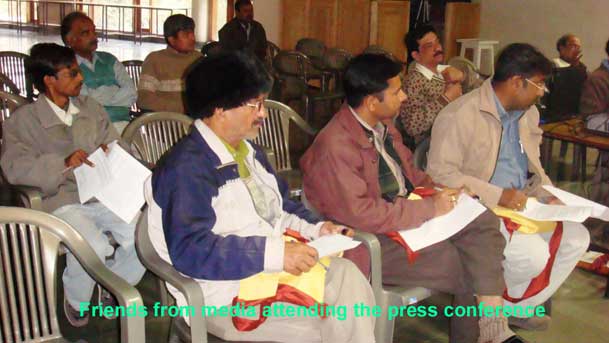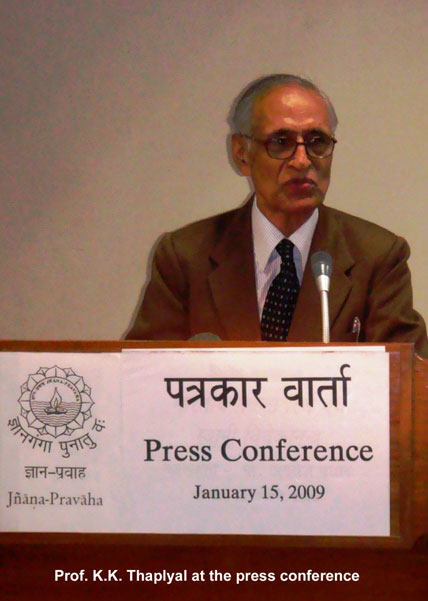Discovery of a New Inscription of
Mauryan Emperor Ashoka
The Jnana-Pravaha - Centre for Cultural Studies & Research, Varanasi is accredited with the discovery of a new inscription of the great Mauryan Emperor Ashoka (270-230 BCE) at Ratanpurwa (Lat. 25°1"N & Long. 83°4"E), which is located in the Kaimur hill range on the border of Uttar Pradesh and Bihar. The inscription, which was engraved by Ashoka on the outer surface of a cave, now falls within the periphery of Ratanpurwa, and hence, was named after this village. The Institution published a monograph on its discovery. The Archaeological Survey of India declared this find as one of the outstanding achievements of last fifty years and has named it as the Basaha Minor Rock Edict.
The Incident of Discovery
The residents of Ramnagar, Varanasi, Shri Virendra and Shri Vinay, suddenly brought a photograph of an inscription to Jnana-Pravaha on the 10th of January 2009. They obtained it from Shri Devi Dayal Maurya, a teacher in a school at Pandit Deen Dayal Upadhyaya Nagar (erstwhile Mughalsarai). Although the script and contents of this inscription were alien to them, but they revealed the location of the cave in which it is inscribed. A number of letters in this poor quality photograph were illegible, and therefore, Dr. Niraj Pandey and Shri Samrat Chakravorty of Jnana-Pravaha visited the site on 12th of January and captured several photographs of the inscription from different angles and also recorded its dimensions. Ultimately, the 'Script Unit' of Jnana-Pravaha, which was conceptualized and set in motion in 1999 by its Former Director/Acharya Late Prof. R.C. Sharma, took the responsibility of deciphering it. The project was headed by the Senior Fellow of the Institution Prof. K.K. Thaplyal from Lucknow and assisted by Dr. Niraj Kumar Pandey and Dr. Chandra Neel Sharma of Jnana-Pravaha, Varanasi.
Being assured that this new discovery is certainly significant and is an authoritative addition to the already existing seventeen Minor Rock Edicts of Ashoka, a Press Conference was called on the 15th of January 2009 to officially announce the recovery of a New Ashokan Inscription. This meet was chaired by Dr. Pramod Chandra, Professor of Indian Art, Harvard University, USA, and also attended by several renowned scholars, including Prof. T.P. Verma, an eminent scholar of Indian epigraphy and palaeography. Prof. Thaplyal unveiled the contents and importance of the inscription, which were then captured and flashed by the television, radio and newspapers the next day. This crucial discovery was immediately reported to Dr. B.R. Mani, Joint Director General, Archaeological Survey of India, New Delhi through fax and email for further necessary action. After the discovery of Sannati (Karnataka) Rock Edict in 1989, this new inscription of Ashoka at Ratanpurwa saw the light of the day after a long gap of twenty years.
The Characteristics of Ashokan Inscriptions
The inscriptions of Ashoka are recovered from various sites and are broadly classified into Rock Edicts, Minor Rock Edicts, Pillar Edicts, Minor Pillar Edicts and Cave Inscriptions for the convenience of study. The last inscription recovered at Ratanpurwa is numbered 18th in the class of Minor Rock Edict. The earlier seventeen being - (1) Sasaram or Sahasram in the Rohtas district of Bihar; (2) Ahraura in the Mirzapur district of Uttar Pradesh; (3) Rupnath in the Jabalpur district of Madhya Pradesh; (4) Gujarra in the Datia district of Madhya Pradesh; (5) Pangurariya in the Sehore district of Madhya Pradesh; (6) Bahapur near Delhi, (7) Bairat in the Jaipur district of Rajasthan; (8) Maski, (9) Gavimath and (10) Palkigundu, all in the Raichur district of Karnataka; (11) Siddapur, (12) Brahmagiri and (13) Jatinga-Rameshwar, all in the Chitaldrug district of Karnataka; (14) Nittur and (15) Udegolam, both in the Bellary district of Karnataka; (16) Erragudi and (17) Rajula Mandagiri, both in the Kurnool district of Andhra Pradesh. This 18th Minor Rock Edict of Ashoka from Ratanpurwa is located in the Bhabhua district of Bihar.
Besides the four scripts, i.e. Brahmi, Kharoshthi, Greek and Aramaic, Ashoka used three languages in his inscriptions, viz. Aramaic, Greek and Pali/Prakrit to communicate his messages to the subject residing in different regions and understanding different scripts and languages within his vast empire. All his inscriptions recovered within the fringe of present India are found to be engraved in Brahmi script and Pali/Prakrit Language (with regional variations), including this new inscription from Ratanpurwa.
The Ashokan inscriptions are further classified broadly into two types on the basis of contents: (i) Buddhist (those meant exclusively for the Buddhist monks and Buddhist lay devotees) and (ii) Non-Buddhist (those propagating his policy of Dhamma and aimed at the people in general). This inscription essentially belongs to the first type.
The Ratanpurwa Inscription
This inscription is engraved on a carefully prepared surface, where the rough wall is made smooth by chiselling. It is engraved in nine lines containing almost uniform sized typical Ashokan Brahmi letters within the area of 100x46 cms. The first line occurs at the height of about 2.95 metres from the floor and the last line at 2.39 metres. The language used in this inscription is the Magadhi form of Prakrit.
Ashoka in this inscription says that it is more than two-and-a-half years that he has been a lay worshipper of the Buddha (upasaka). But initially he did not make significant progress. But it is more than one year that he became associated with the sangha and thereafter acted zealously. By his great efforts, he made the people of Jambudvipa (India) so virtuous that even gods came on earth and mingled with them. He says that not only men of high ranks, but even those of low ranks can attain heaven if they zealously lead a virtuous life. He wanted that the people outside the border of his Empire too should know how zealous Ashoka was for the cause of Dhamma and what he had achieved. He expresses hope that the effect of his zealous effort will increase and last long. He informs that this proclamation was made by him when he was on tour for two-hundred-and-fifty-six days. He instructs that the inscription should be engraved on rocks and on pillars if they are available.
Notable Features
The newly discovered Ratanpurwa Minor Rock Edict of Ashoka, hence, is an important addition to the existing seventeen versions and certainly contributes to enrich the Indian Culture. Its clarity of alphabets and well-preserved state certainly deserve special mention and attention of all. Its remote location, difficult access, Buddhist subject, natural rock floor-area for audience to sit are some of its peculiarities, which force us to believe that this inscription was certainly not meant for the common people, but exclusively for the Buddhist monks and Buddhist lay worshippers, who could make extra effort to reach the place in order to receive blessings of Lord Buddha. The place for engraving this inscription, without doubt, was selected purposefully by his officers as they knew that Ashoka's aim was certainly to let those associated with Buddhism know what he himself was doing (and intended to do in future) for the propagation and furtherance of Buddhism within his empire and outside.
Acknowledgement
The Jnana-Pravaha will always remain thankful to Shri Narendra Kushwaha, Shri Rama Shankar and other villagers of Ghurahupur, who rendered all the help during our visit to the site. Special thanks are due to Shri Mahendra Rajbhar of the same village, who not only guided us to the spot of inscription, but also extended all types of help and support and tried to make us at ease on the risky and difficult location.


